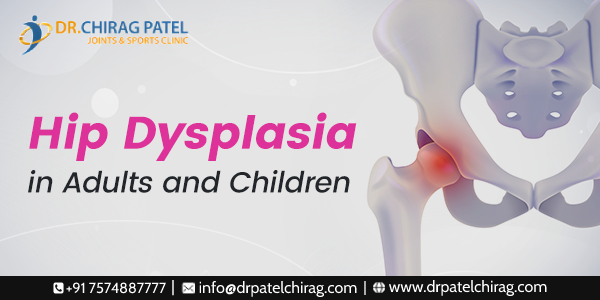The hip is a robust ball-and-socket joint where the femoral head (the ball) fits into the acetabulum (the socket), allowing smooth movement and optimal weight distribution. Unfortunately, in cases of hip dysplasia, this proper fit doesn’t happen. The ball may not snugly fit into the socket, leading to instability, friction, early wear and tear, ultimately resulting in early-onset arthritis.
“Patients with hip dysplasia often experience pain and instability, limping, restricted hip movements, ultimately leading to hip joint dislocation, and the need for joint replacement,” says Dr. Chirag Patel, a consultant in hip replacement and a joint replacement specialist in Mumbai.
In short, hip dysplasia is a painful condition that progressively worsens with age. Unfortunately, this condition can affect patients of all age groups – from babies to adults. In this blog, let us find out about the outlook of this condition in both babies and adults.
Hip Dysplasia in Babies & Children
In babies happens when the hip joint is not adequately formed at the time of birth. It is considered a congenital condition affecting around 3 in 10,000 babies born every year. In 50% of cases, dysplasia can be stealth, where the baby shows no symptoms, making early detection a key factor in babies. This type of dysplasia is called congenital dysplasia.
While babies can be born with hip dysplasia, the condition can also develop in infancy and childhood due to swaddling practices, genetic factors, or other causes. On average, is more common among girls than boys, particularly among first-born babies with larger birth weight.
Treatment for Hip Dysplasia in Babies:
Uneven leg folds, limited leg movement, clicking or popping sounds, and uneven leg lengths are some of the common symptoms of hip dysplasia in babies. Limping, waddling gait, uneven thigh and buttock development, and leg rotation restriction are some of the symptoms of dysplasia in children.
Pelvic harnesses, bracing, ultrasound monitoring, and physical therapy are some of the most common methods used to treat and correct in babies and children. Surgery is often not necessary and is only recommended when all other options fail to correct the situation.
Causes in Adults: :
Undiagnosed and unidentified hip dysplasia in childhood can persist into adulthood and manifest as severe hip dysplasia in adults. In some cases, it can also be acquired, resulting from excessive stress, physical trauma, and injury. “In some cases, patients have a genetic predisposition to develop ; in others, it can be a side effect of arthritis or even pregnancy-related hip changes, particularly in women,” says joint replacement specialist in Mumbai, Dr. Chirag Patel.
Untreated Hip Dysplasia in Adults Symptoms:
Hip pain, limping, reduced range of motion, hip instability, and discomfort during physical activity, and early onset of arthritis are common symptoms of hip dysplasia in adults. Conservative treatment for hip dysplasia in adults includes pain medication, lifestyle modification, pain management, weight management, and physical therapy, which is often employed to relieve pain and improve the condition when conservative treatment options fail to deliver the right results.
Hip arthroscopy, Periacetabular osteotomy, total hip replacement surgery are other surgical options that are leveraged by hip and joint replacement surgeons to correct in adults. For more information on hip dysplasia in children and adults, you can contact top joint replacement surgeon and hip replacement specialist in Mumbai, Dr. Chirag Patel .





